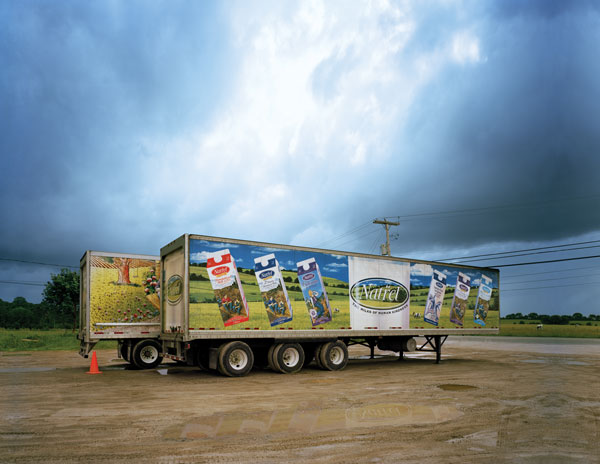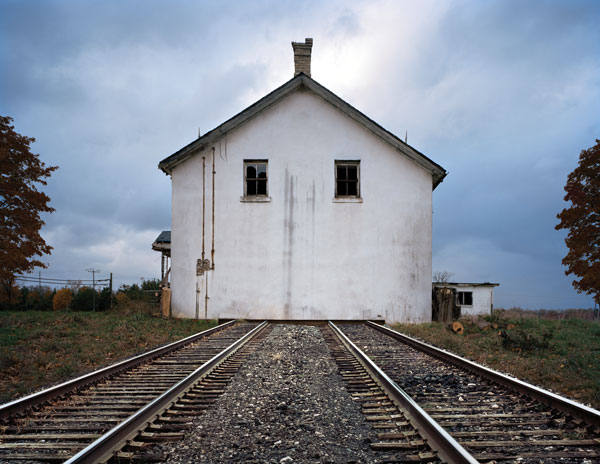[Winter 2011]
Susan Dobson
Dislocation
The Department Gallery, Toronto
September 7 to 25, 2010
All of the large-scale colour photographs making up Susan Dobson’s recent Toronto exhibition “Dislocations” contribute in varying ways to her notion of dislocation as a modification – as she puts it on her Web site – of “time, space and geography, where surroundings can seem both familiar and foreign.” She notes, as well, that “a pervasive and persistent form of déjà vu dominates the work, derived in part through the combination of digitally manipulated images with photographs shot in the documentary mode.” If this all seems rather conventional, even well trodden, as a procedural direction, the photographs themselves nevertheless offer enough insinuating visual wit (replete with visual puns and rhymes) and self-consciously theatrical sparkle, as well as an unabashedly literary sense of playful grotesquerie, to lift them sufficiently above whatever seems commonplace in the artist’s suggestions about the juxtaposition of digitalization and straight documentary.
Like the deadpan but demonic photographs in Dobson’s show “Retail” of a few years ago (big-box stores in evacuated parking lots, each of them digitally homogenized into bearing identical, uninflected, matte gray surfaces), the photographs in “Dislocation” play amusingly bleak dystopian games about what is now and what, consequently, might be hereafter (as Dobson wrote to me in a recent e-mail, “I am interested in photography’s ability to foreshadow the future, and even conflate tenses in the same work”). It is not easy to imagine how something that presumably lies embedded in a photograph – innate within it – can “foreshadow the future” (as a medium, photography is pretty good, admittedly, at embalming the past). It is rather more likely, is it not, that it is something in the photographer himself or herself that pushes the camera into the speculative realm of some recordable future ?
In Holdout, for example, a noble but tragicomically isolated Victorian or Edwardian house sits centrally, with what is nevertheless the unconvincing triumph of its stalwart immovability, on a hillock of gravel (its towering TV antenna like a cry for help to the outside world). Its owner has clearly refused to sell to some developer. So far, the juxtaposition of lonely, venerable house and its arid, soon-to-be-transformed surroundings is a bit shocking, a bit dismaying, a bit ruefully funny, and borderline poignant. While this imagistic juxtaposition may not take us all the way to prophetic, it certainly works, nevertheless, to “conflate tenses in the same work.” Much of the juice of the picture appears, in fact, to lie in its formal construction – a mode in which Dobson excels. There is a good deal of visual frisson in the jarring coming together of the house’s sudden verticality and the horizontal neo-plain now sidling up everywhere, threatening its dignity.
End of the Line works in a similar way. It’s funny at first (reminiscent of those shacks full of dynamite that some evil creature is always dragging onto the tracks in classic Warner Bros. cartoons). Then, because the placing of the house seems so deliberate (the façade is notched to admit the tracks), the photograph turns anxious (have any trains been through here recently ?) and then touching. Here, the image offers a sort of morphological slapstick – a rather abruptly felt exemplifying of what Dobson called (in her e-mail) the idea “of open-ended, shifting, and multi-narratives and uncertain temporalities.”
For me, Dobson is at her strongest and most telling when, in a work such as Human Kindness (as in the milk of human kindness), she binds her “multi-narratives and uncertain temporalities” (or uncertain “spatialities”) to the found – and cunningly observed – environment. Here, for example, the milk-carton landscape borne by a Natrel truck seems surprisingly co-extensive with the landscape in which the truck is parked.
And in Fire Hall, the energy of the photograph seems to lie not so much in its symmetrically organized depiction of a defunct green fire-hall (if that’s what it is), flanked mysteriously – digitally – by identical automobiles and light standards and other matching bits of urban ephemera, but, rather, in its absorbing graphic griddedness (amplified by the solitary, non-symmetricizing gridded wooden panel leaning on the building). Here, Dobson’s interest in “uncertain temporalities” has been deferred to some stance that is entirely consequent upon our getting past the design blandishments that hold the photograph fixed in our field of vision – from which it seems stubbornly reluctant to move away so that we might now contemplate “the future perfect” tense in her pictures, in which issues (the dislocations of cultural change) can take precedence over incidents (symmetry, graphics, etc.).
Mysteriously, it is in a handful of deliberately lurid photographs such as Display (variously coloured lights on standards, illuminating a well-clipped, fenced-in greensward) and Transmission (an isolated telephone booth as a tiny, vertical island of illumination in a sweeping horizontal of darkness) that Dobson’s poetic sense of the fluidity of time, of the oddity of proximate spaces, comes fully, inescapably into its own. Even here, however, her fecund, unquenchable narrative sense sometimes threatens to take over – as when, in Lake Bed, the surrealist-derived crocodile in the foreground pins the majesty of Dobson’s burgeoning, photographically ambitious speculations to an anecdotal present.
Toronto writer, critic, and painter Gary Michael Dault is the author of ten books. His art review column appears each Saturday in The Globe & Mail.


